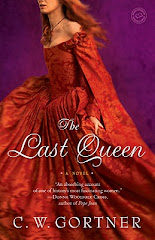 I'm delighted to welcome Laurel Corona, a friend and colleague whose latest novel THE MAPMAKER'S DAUGHTER is now available. Set in 15th-century Spain, this beautiful and vivid novel explores the forgotten women of the Spanish Inquisition, as seen through the eyes of Amalia Riba, a converso forced to hide her religion
from the outside world, She is the last in a long line of Jewish mapmakers,
whose services to the court were so valuable that their religion had been
tolerated by Muslims and Christians alike.
I'm delighted to welcome Laurel Corona, a friend and colleague whose latest novel THE MAPMAKER'S DAUGHTER is now available. Set in 15th-century Spain, this beautiful and vivid novel explores the forgotten women of the Spanish Inquisition, as seen through the eyes of Amalia Riba, a converso forced to hide her religion
from the outside world, She is the last in a long line of Jewish mapmakers,
whose services to the court were so valuable that their religion had been
tolerated by Muslims and Christians alike.
But times have changed. When King Ferdinand
and Queen Isabella conquer Granada, the last holdout of Muslim rule in Spain,
they issue an order expelling all Jews who refused to convert to Christianity.
As Amalia looks back on her eventful life, we witness history in the making—the
bustling court of Henry the Navigator, great discoveries in science and art,
the fall of Muslim Granada, the horrors of the Spanish Inquisition. And we
watch as Amalia decides whether to relinquish what’s left of her true self, or
risk her life preserving it. This is a sweeping saga of faith, family and
identity that shows how the past shapes our map of life.
Please join me in welcoming Laurel Corona, who offers us this interesting perspective on the famous Henry the Navigator.
Henry the Navigator and
his “Gay Company”
When I was in grade school I always thought Henry the Navigator
was the coolest figure in the Age of Exploration, but there were a number of
things my teachers didn’t share, or didn’t know, about him. He was the first to
kidnap Africans for economic gain and and bring them as slaves to Europe. He
also never navigated, staying on dry land the entire time his ships went off to
discover the world. And one last thing:
he was almost certainly gay. Researching Henry for my new novel, THE MAPMAKER’S DAUGHTER, I
ran across an early historian who said that the prince “spent his whole life in
pure chastity, and went to his grave as a virgin.” Another said that "he
did not wish to marry because of his great chastity." A third added that
"he always lived so virtuously and chastely that he never knew a
woman."
Of course “chaste” does not equal gay, so let’s dig a little
further.
 What might his brother, King Duarte, have meant when he wrote
Henry to say he should avoid "giving pleasure to men" beyond what he
could do in a "virtuous manner"? What does one contemporaneous historian mean when he describes
Henry’s household as “habituated to the gay and spontaneous company of his
servants,” adding that, “he was very attached to them”? This archaic use of the
word “gay” always brings a smile to modern lips, but the point about Henry’s
preferences is not contained in that word.
What might his brother, King Duarte, have meant when he wrote
Henry to say he should avoid "giving pleasure to men" beyond what he
could do in a "virtuous manner"? What does one contemporaneous historian mean when he describes
Henry’s household as “habituated to the gay and spontaneous company of his
servants,” adding that, “he was very attached to them”? This archaic use of the
word “gay” always brings a smile to modern lips, but the point about Henry’s
preferences is not contained in that word.
What does it mean that most of those Henry gave the chance to
conduct highly lucrative slave raids in West Africa were young men raised from
youth in his "câmara"? When his early biographers used this word, its
most common meaning was bedroom, or by extension the private quarters of his
palace, where it is apparent from the sources that many young men (and never a
woman) were free to come and go in a manner befitting a prince’s most intimate
friends.
In The Mapmaker's Daughter, Diogo Marques is one
of Henry’s handsome young favorites who subsequently receives a commission to
go slaving. My protagonist Amalia, not
yet in her teens when she goes to Henry’s court with her father, wonders about
this absence of females in the palace.
Though later she will pay for her naivete, at the time she simply
grumbles that if there were women around, someone might notice she had outgrown
her clothes.
 Biographers during his lifetime and the century afterward
tiptoed delicately around the subject of Henry’s personal life for good
reason. Sodomy was a grievous sin and a
crime punishable by death. To make the
heinousness even clearer, after execution (or as a means of it) the body of the
accused had to be so thoroughly destroyed by fire that no trace remained. It was common to exhume the dead to desecrate
their bodies if offenses of this and other sorts were discovered later. Obvious, honesty both during and after
Henry’s lifetime was not consistent with building him into the national hero of
Portugal, so biographers kept their silence.
Biographers during his lifetime and the century afterward
tiptoed delicately around the subject of Henry’s personal life for good
reason. Sodomy was a grievous sin and a
crime punishable by death. To make the
heinousness even clearer, after execution (or as a means of it) the body of the
accused had to be so thoroughly destroyed by fire that no trace remained. It was common to exhume the dead to desecrate
their bodies if offenses of this and other sorts were discovered later. Obvious, honesty both during and after
Henry’s lifetime was not consistent with building him into the national hero of
Portugal, so biographers kept their silence.
And then there’s very phallic personal crest Henry designed,
which would raise the eyebrows of anyone who has ever heard of Freud. It seems there is much more to Henry than the
well-dressed prince looking to sea with a model ship in his hand.
Thank you, Laurel. To find out more about Laurel and her work, please visit her website.













No comments:
Post a Comment